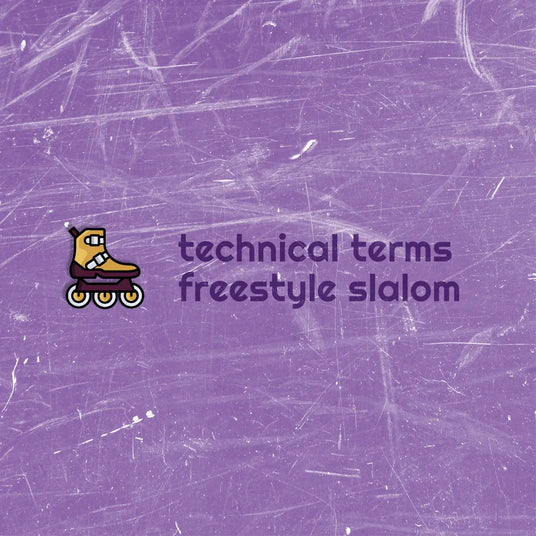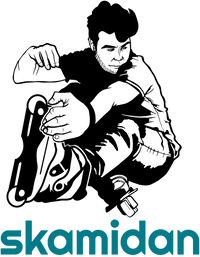
Inline Freestyle Slalom Skating
Technical terms and vocabulary
When you dive into the world of Inline Freestyle Slalom Skating, you'll quickly come across many technical terms and vocabulary that may be unfamiliar or unclear to beginners.
From various trick names and technical terminology to specific setup designations – this glossary will help you keep track of it all.
Overview
Technical terms and vocabulary – Inline Freestyle Slalom Skating
Table of contents
In these alphabetically sorted lists, you'll find the most important terms related to Inline Freestyle Slalom Skating – clearly explained and ready to use, whether you're a beginner, an advanced skater, or simply curious.
The best part: Our glossary is continuously being expanded.
Vocabulary – Inline Freestyle Slalom Skating
Technical terms for hardware in Inline Freestyle Slalom Skating
- A (Wheel Hardness / Shore Hardness)
Synonym or designation for wheel hardness. "A" stands for Shore hardness (named after inventor Albert Ferdinand Shore). - Adjustable Rocker
The rocker function refers to the ability to individually adjust the height of certain wheels on an inline skate or its frame.
This allows for flexible switching between a flat setup (all wheels at the same height) and a rockered setup (different wheel heights for increased maneuverability). - Anti Rocker (Setup)
An anti-rockered setup refers to a wheel arrangement where the middle wheels are positioned higher than the outer ones.
This setup is commonly used in aggressive inline skating to create more space for grinds — but it is not used in freestyle slalom skating. - Banana Rocker (Setup)
A banana-rockered setup is a specific form of rocker setup where the frontmost and rearmost wheels are positioned higher than the middle wheels (in a 4-wheel setup) or than the center wheel (in a 3-wheel setup).
As a result, the skater is always riding on just two wheels, which shortens the effective wheelbase and creates maximum maneuverability and agility.
This setup is especially common in freestyle slalom skating. - Flat (Setup)
A flat setup refers to a wheel arrangement where all wheels are mounted at the same height.
This is the standard in general inline skating and provides a stable ride with consistent ground contact. - Frame
Synonym for chassis — the central connecting element between the wheels and the boot of an inline skate. - Frame Length
Length of the frame, from the first to the last wheel. - Hardboot Skate
A hardboot skate is an inline skate with a rigid outer shell, offering especially strong support, stability, and hold — as opposed to softboot skates, which are softer and more flexible. - Natural Rocker (Setup)
A pre-rocker refers to an inline skate or frame with a fixed, pre-rockered wheel setup, in which the wheel heights are not adjustable. - Progressive Rocker (Setup)
A progressive rocker setup is a special wheel setup in which the wheels are arranged at three different heights.
At any given time, only two wheels touch the ground, allowing for extremely high agility.
Example (5-wheel setup):
The frontmost and rearmost wheels are in the highest position
The second wheels from the front and back are in a medium position
The center wheel is mounted at the lowest point
This setup provides a highly dynamic skating experience with refined edge control and is used, for example, in wizard skating. - Rockered (Setup)
A rockered setup refers to a wheel configuration where at least one wheel (front or back) is positioned higher than the middle wheel(s).
This setup is the standard in freestyle slalom skating and allows for high maneuverability and precise movements. - Wheelbase
The wheelbase refers to the distance from the center of the frontmost wheel to the center of the rearmost wheel that touches the ground simultaneously. - Wheel Hardness
Wheel hardness is indicated by A-values (e.g., 85A) and significantly influences ride characteristics.
It affects rolling resistance, speed, and grip:
On smooth surfaces, softer wheels are recommended for better grip and cushioning.
On rough asphalt, harder wheels are more suitable as they are more durable and roll more easily. - Wheel Profile
The wheel profile describes the shape of the contact surface — how round or flat the wheel is and how large the surface area touching the ground is.
Freestyle slalom skaters usually prefer a round profile.
It ensures even ground contact at all angles and supports smooth directional changes, controlled spins, and precise edge handling.
Vocabulary – Inline Freestyle Slalom Skating
Technical terms for trick descriptions and skating techniques in Inline Freestyle Slalom Skating
- 180°
180° indicates the degree of a turn and thus describes a “half turn”. - 360°
360° indicates the degree of a turn and thus describes a “full turn”. - 540°
540° indicates the degree of a turn and thus describes a “1.5x turn”. - 720°
720° indicates the degree of a turn and thus describes a “double turn”. - 900°
900° indicates the degree of a turn and thus describes a “2.5x turn”. - 1080°
1080° indicates the degree of a turn and thus describes a “triple turn”. - Backwards
The term "Backwards" refers to skating backwards in inline skating, or to a trick that is performed while skating backwards. - Combo
In inline freestyle slalom skating, the term "Combo" (short for “Combination”) refers to a combination of several tricks that are performed smoothly and without interruption – typically within one or more slalom lines. - Cone
The term "Cone" refers to the small pylons or slalom markers used in inline freestyle slalom skating. - Edge control
Edge control is the "invisible technique" that makes many tricks possible. It is a sign of advanced skating skills and a key to a clean, expressive slalom style.
The inside edge is the side of the wheel facing the center of the body.
The outside edge faces away from the body.
In skating, these edges are activated by shifting body weight and angling the skates.
Clean edge control allows for controlled spins, slides, and changes in direction – especially important in combos and transitions. - Front
The term "Front" refers to performing a trick while skating forward. - Heel Wheeling
In inline freestyle slalom skating, the term "Heel Wheeling" refers to skating only on the rear wheel (heel) of a skate – that is, on a single wheel per foot, and specifically on the heel. - Jump
In inline freestyle slalom skating, the term "Jump" refers to a jump where the skater lifts both skates off the ground simultaneously – often over slalom cones, during a trick, or as part of a combo. - Line
In inline freestyle slalom skating, the term "Line" refers to a full choreography or trick sequence that a skater performs through one or more slalom lines – usually during a competition (Freestyle Classic) or a show performance.
A line consists of many connected combos and tricks, usually covering the full length of the slalom line. - One Foot
In inline freestyle slalom skating, the term "One Foot" refers to skating on only one foot, while the other foot is lifted off the ground. All wheels of one skate are in contact with the ground – in contrast to Wheeling, where only one wheel (toe or heel) touches the ground. - Pivot
In inline freestyle slalom skating, the term "Pivot" refers to a turning movement around a fixed wheel – usually on one leg – where the skater spins around their own axis while one wheel remains as the pivot point on the ground. - Slide
The term "Slide" refers to a controlled glide over the surface, in which the skater intentionally makes the wheels slip rather than roll normally. - Spin
The term "Spin" refers to a fast, multiple rotation around the skater’s own body axis, performed on one or both skates – typically within a slalom line. - Switch
"Switch" refers to performing a trick on the individually weaker or less practiced side or direction.
This can refer to: the non-dominant foot (e.g., left foot instead of right),
the unfamiliar turning direction (e.g., counterclockwise instead of clockwise),
a more difficult edge position (e.g., outside edge instead of inside). - Toe Wheeling
In inline freestyle slalom skating, the term "Toe Wheeling" refers to skating only on the front wheel (toe) of a skate – that is, on a single wheel per foot, specifically on the toe. - Transition
The connection between two tricks, a change of direction, or linking two different obstacles. - Wheeling
In inline freestyle slalom skating, the term "Wheeling" refers to skating on only one wheel of a skate – either on the front wheel (Toe Wheeling) or the rear wheel (Heel Wheeling). The body weight is intentionally shifted onto a single wheel, while the other skate either rolls along or is lifted. - Zigzag
A change of direction, or many changes of direction in quick succession.
